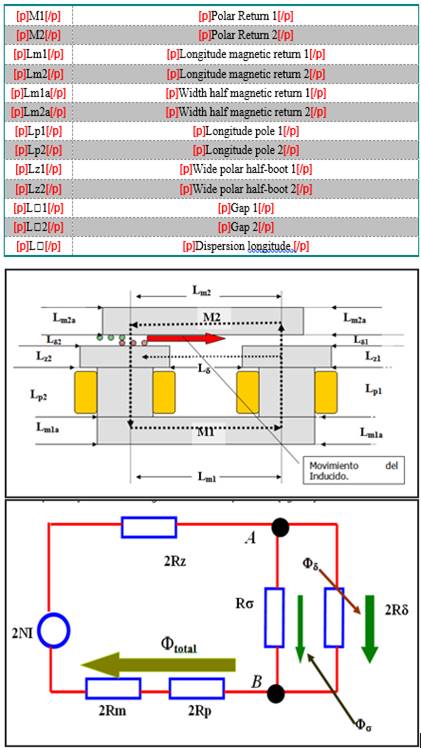Introduction
Initial analysis of the synchronous generator of low reversibility
When it is looked for to improve the consumption of primary energy in sustainable form, it is very difficult to accept a successful search in modifying the today excellent synchronous generator, the one without doubts more efficient link of the immense majority of the renewable energy chains or not at the moment, this paradoxical form of facing today the sustainable saving, it has already happened in past times in solutions of punctual problems, a good example was the railroad; specialists of that time considered completely absurd to even displace a flat wheel on a flat rail and worse one, a rail loading a great weight, today nobody puts in area of doubts the success of the railroad in transporting very heavy loads.
The present work it is can consider a scientific investigation because it is an intellectual activity guided toward new human knowledge and it is achieved it by means of a scientific methodology of investigation based on the use of a deductive hypothetical methodology aided in obtained data, principles and more general laws of the electric engineering, as well as the systemic method when modeling the object starting from their components, their parameters and the relationship among them, it has more than enough everything a dialectical base that always characterizes to all the sciences in the middle of enrichment [1].
This work completes with:
To refer to a real situation.
The used variables are comprehensible and an appreciable precision exists in their values.
Logic exists among the interrelations of the used variables.
The exposed electromechanical parameters and the relationships outlined among them are visible, as well as they can repeat, to verify and to measure.
The present work constitutes a guided fundamental investigation, therefore its objective is exclusively to show new knowledge based on observed facts and measured in a new synchronous generator proposed to evaluate, these facts differ of the synchronous generators at the moment in the international market, fundamentally to be designed based on minimizing the antagonistic electromagnetic torque, great culprit of the current high consumption of primary energy during its use in renewable energy or not; therefore it is inferred that a grade of such termination is not reached that allows its direct commercial application, but yes it demonstrates a new one in route to perfecting. Logically today the synchronous generator is not far away of the current technological development, that which is manifested mainly in: the excitatory is coupled to the winding inductor without rings, coal less, for a system of bridge revolvable rectification; the automatic regulator of tension has high level integrated circuits, operation under diverse conditions of the load, soundproofed, against undesirable oscillations, filters against radio interferences emitted for industrial atmospheres, it possesses permissible overexcitement should the need arise; good dimensions to high power and nominal speed due to the elevation of the quality of the magnetic circuit; possibility of use of static systems of excitement in the control of big synchronous generators; and more new improvements. Nevertheless it’s previously shown, it has stayed basically by more than for century in the magnetic circuit proposed by Warner
Von Siemens, today in the current synchronous generators, except for generators that take advantage of modern permanent magnets used fundamentally inside the wind power energy. Among approximately 20 types of existent synchronous generators at the beginning of the XX century, the one designed by the eminent British engineer Zianni Ferranti that give service in London in 1902 it is chosen, with a nominal power of 1,5MVA and 150 rpm (figure 1), whose technology stopped to be manufactured in 1914 in the face of the strength of the technology outlined by Siemens and that definitively it even reigns today; but the existent panorama in those distant years differs substantially of the effective today, where the cost of the primary energy, the development necessity and the care of the environment struggle technologically to look for a true sustainable energy.

Fig. 1 Left: Two-phase synchronous generator (not yet three-phase existed) that gave service in London with a power of 1,5MVA in 1902[2]. Center: Synchronous generator in Barcelona 1909, all designed by Zianni Ferranti (1864 - 1930) [3]. Right: Current state of one of the generators of Ferranti conserved in the Museum of Sciences and Industries, Central Collection, Manchester, United Kingdom[4].
Development
Synchronous generator of low reversibility
a) Why low reversibility
The synchronous generator of low reversibility is product of studies, investigations and experiments already based on the alternator Ferranti mentioned along more than 3 decades, but with an objective of very specific design: to diminish the antagonistic electromagnetic torque to the revolvable movement of the used primary motor, main cause of the high consumption of primary energy in the electricity production using generators (figure 2); this synchronous generator of low reversibility is registered officially like patent of invention (DIGERPI Panama Nº 91113 D-1) with that same name in Spanish.
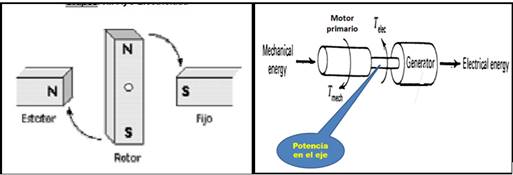
Fig. 2 Way at the moment electric power is generated: Making rotate a highly magnetized rotor whose antagonistic torque conquers spending big quantities of primary energy daily.
The world changed technical and economically from those already distant years of final of the XIX century and principles of the XX century in that were born motors and electric generators successfully, the concept of sustainable development and conservation of the environment is relatively new, in this technical context - economic very real the roots of the current synchronous generator are the same of the original times of Siemens, the synchronous generator and the synchronous motor they dive in very similar constructive bases, of course the synchronous generator is not absent to the imposing world technological development as it was already mentioned previously, but the carried out efforts its conceptual bases has not changed in a very different world in its priorities.
It is of elementary knowledge, considering constant speed of rotation, which in an electric generator an input mechanical power is introduced, that which is: equation (1).
That torque (TTotal) antagonistic to the motor movement it is constituted for: equation (2).
Where JRotor θ it is the torque of inertia of the rotor, TFriction it is the torque of friction of the rotor and TLoad it is the antagonistic torque exercised in the shaft due to its main magnetic circuit (rotor - stator) and to the electric current in the load, denominated electromagnetic torque; being this last one much bigger quantitatively, that is to say that fundamentally most of the mechanical power given in the shaft wastes away in conquering this noxious torque; in the case of the synchronous motor the electromagnetic torque is in favor of the movement.
Conceptually it calls himself reversible process to that change of state of the system (or of a body for separate) that, to the being carried out in contrary address, it returns to its initial state, so the system passes through the same intermediate states that in the direct process, but in inverse order and the state of the external bodies to the system are invariable [5].
In electric machines the reversibility principle therefore is the one that implies that a motor can be used as generating or vice versa, if this happens based on the form that the electromagnetic torque acts: negative or positive, if it is designed minimizing the electromagnetic torque, its reversibility will be low.
B) Construction
The synchronous generator of low reversibility resembles each other constructively to an axial generator of permanent magnets, but the inductor flow magnetic born in winding poles, that which facilitates the quantitative control of the same one (figure 3), physically the ferromagnetic structure is built with carbon steel without laminating in these tests (Cheap steel C20, C45).
Up left: Rotor with induced winding three-phase. Up right: Lateral view of the circuit magnetic inductor, without rotor. Below left: Back view of the synchronous generator of low reversibility. Below right: Lateral frontal of the synchronous generator of low reversibility.
The magnetic circuit of the synchronous generator of low reversibility for its analysis is: See figure 4.
Basically it is completed according to the Law of Hopkinson that likens magnetic circuits to the Law of Ohm that: equations (3) y (4).
c) Main parameters
All the parameters are obtained to constant speed 1500 rpm (4 poles), first the characteristic is No - Load (figure 5), and then of Short CircuitCharacteristic (figure 6), being these characteristics limits of the generator.
Rotating manually until obtaining maximum values and minima obtains in an experimental way the values Xd y Xq: equations (5), (6) y (7).
For all that which, then the short circuit relationship (SCR) it is: equation (8). See figures 5 and 6.
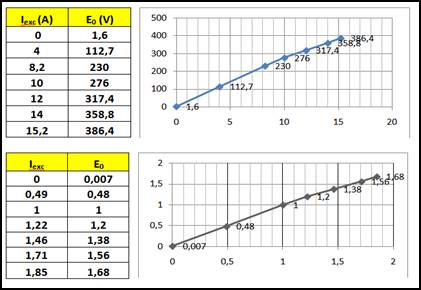
Fig. 5 No-Load characteristic synchronous generator of low reversibility 12kVA, 10kW, 4 poles, 1500rpm in real units and relative units.

Fig. 6 Short Circuit Characteristic 12kVA, 10kW, 4 poles, 1500rpm in real units and determination of Xq, Xd
They are shown the external characteristic (figure 7), and also the regulation characteristic (figure 8). See equations (9) and (10).
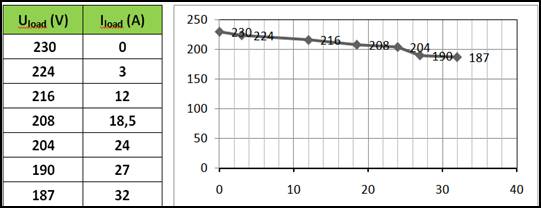
Fig. 7 External characteristic synchronous generator of low reversibility 12,5kVA, 10Kw, 4 poles, 1500rpm.

Fig. 8 Characteristic of regulation synchronous generator of low reversibility 12,5kVA, 10Kw, 4 poles, 1500rpm
Calculation of the efficiency of the electric generator of low reversibility 12,5kVA, 10kW, 230V, 4 poles, 1500rpm constant with the equation (11). See table 1.
Tabla 1 Calculo eficiencia de generador.
| Nominal power | 10 kW |
| Seem power | 12,5 kVA |
| Total mechanical losses | 0,32 kW |
| Total steel losses | Not |
| Total cooper losses | 1,21 kW |
| Total other losses | 0,055 kW |
| Total losses | 1,585 kW |
| Efficiency | 86,32% |
D) Comparison with effective technology.
Stamford is a British company of grateful international prestige that the commercial production of rotational electric machines began in 1904, its commercial model is taken PI044F (figure 9), (12,5kVA, 4 poles, inductive F.P=0,8 1500rpm) corresponding to 2019, to compare with the synchronous generator of low reversibility of similar benefits whose characteristics were shown previously. Figures 10 and 11. See equation (12).

Fig. 10 Comparison effective technologies Stamford 2004 - 2019 / Leroy Somer 2020 [7] and synchronous generator of low reversibility 12,5kVA 10kW 4 poles 1500rpm to full load.
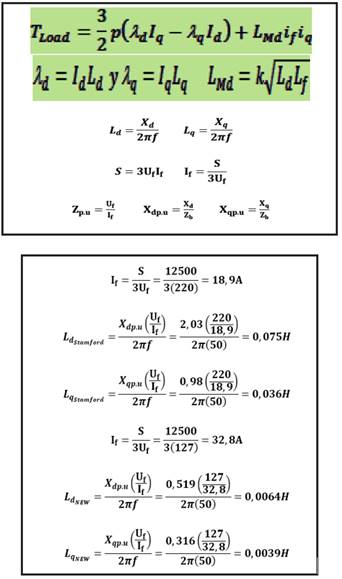
Fig. 11 Comparative analysis of the antagonistic electromagnetic torque parameters between the effective technology and the proposal to equality of power in the load, nominal speed and number of poles based on the equations of Park [8], [9].
It is evident that if Xd and Xq (2,03 ( 0,519p.u and 0,98 ( 0,316p.u ) are significantly inferior, Ld and Lq will be also it, for all that which is shown that the antagonistic torque is smaller when substituting values in the equations of Park that quantify the electromagnetic torque in the synchronous generator of low reversibility for similar load conditions. It could become similar comparative analysis starting of expressing the antagonistic electromagnetic torque in function of the magneto motive forces (m.m.f) of the rotor and the stator or in function of the mutual inductances rotor - stator.
Analysis electromagnetic torque based on the mutual inductances
The mutual inductanceΎ1] MR(S of the winding induced with regard to the winding inductor it is the relationship of the magnetic flow through those NR turns of the winding induced taken place by the magnetic field of the electric current IS through the winding inductor, that is to say: equation (13).
While the mutual inductance MS(R of the winding inductor with regard to the winding induced it is the relationship of the magnetic flow through those NS turns of the winding inductor taken place by the magnetic field of the current to IR through the winding induced, that is to say: equation (14).
Observing the figure 8, are more comprehensible the existence of MR(S(MS(R in a generator of low reversibility because the nucleus of the winding inductor and induced, they are magnetically very different, while the created flows are to each other in colineal way: Inductor ferromagnetic nucleus - Induced air core.
For all that which the equivalent mutual inductance will be: equation (15).
Therefore the determinant (equivalent mutual inductance) it will be: equation (16).
The equation of the antagonist electromagnetic torque in a machine synchronous classic outlined as function of the mutual inductance it is (equation 17).
Because in the synchronous generator of low reversibility, the rotor (induced) it lacks of ferromagnetic nucleus, while in the commercial synchronous generator so much induced as inductor yes, they possess ferromagnetic nucleus, when analyzing the equation 16 it is evident that MS(R , LRotor and therefore the equivalent inductance M will be quantitatively smaller and when substituting in the equation 17 the antagonistic resistant torque it will be smaller.
Conclusions
In spite of the restrictive constructive current ones in our university, the synchronous generator of low reversibility, even in anyone of their variants experienced even in study, it consumes smaller primary energy that the technology at the moment for similar end. It is of also highlighting that the current technology has more than 1 century of continuous improvements, as well as also a very itemized and deep study at the highest cognitive level, including to have the best constructive technologies; for all that which is not exaggerated to affirm that this proposed technology can displace once in very short term the existent today subjected to an indispensable study and development in a constructive one appropriate until reaching nominal powers of commercial character, because today its achievements exist without suitable conditions to achieve it.
The synchronous generator is the less expensive element in anyone of the mentioned energy sources and a positive change in the same one it is a sustainable road of energy saving, because its change doesn't modify the environment and it takes advantage of the infrastructure advantageously already existent.This investigation has not stopped and there is even in study successfully 2 new variants of synchronous generator of low reversibility (radial flow) premature to expose details.














